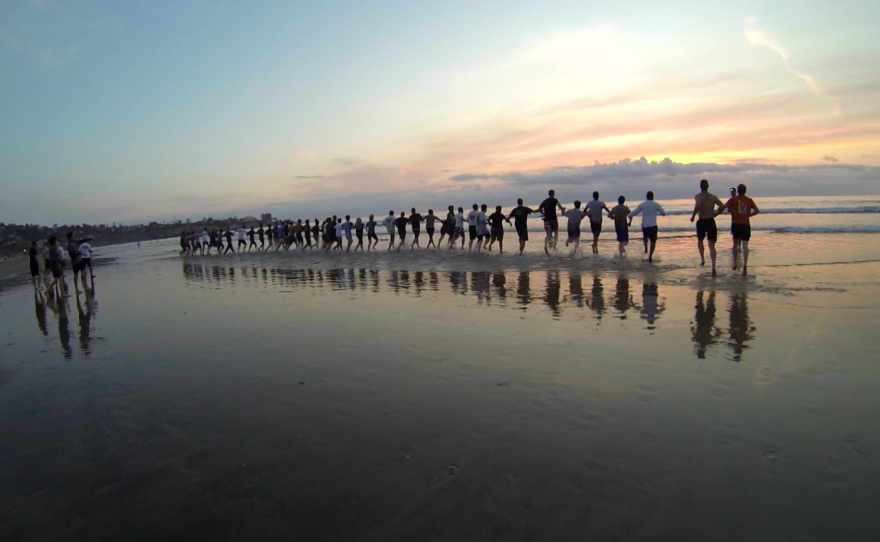Inside the gym at a local Jewish community center, students are kicking, punching and placing each other in headlocks. The men and women — young and older — are learning Krav Maga.
It’s a hand-to-hand street-fighting system formally developed for the Israeli military that’s often taught in the U.S. as a self-defense class.
Teaching the course is Dana Ben Kaplan, lead instructor at Krav Maga San Diego. He's taught males, females, teens and seniors how to break free from multiple attackers or escape a fight in the ocean.
But Kaplan’s real-life training scenarios aren’t just tailored to the average citizen — hidden alongside his students are law enforcement officers.
“I’ve got personnel from U.S. Secret Service, local law enforcement, of course San Diego PD, San Diego County sheriff’s, Border Patrol, Immigration and Customs Enforcement, Department of Homeland Security," Kaplan said.
These law enforcement officers are seeking outside instructors like Kaplan to boost their defensive tactics training.
And with several highly publicized deadly police shootings prompting protests across the country and here in San Diego, the tension has put law enforcement's use of force techniques under a microscope.
Kaplan said he attended a specialized course in Israel that taught him how to adapt Krav Maga techniques for law enforcement scenarios and offers a monthly course for only law enforcement and military personnel.

He said Krav Maga is the best fighting system for law enforcement officers, in part because it gives them options in situations that would have them reaching for their guns. He calls this the “gray area."
“The gray area is the in-between — between shooting and fighting. Because it's easy for law enforcement agencies to teach officers how to shoot — you can go to a range — it’s easy to teach them how to fight. Put them in a padded room, put some boxing gloves and headgear on, but that gray area is not really covered," he said.
Agencies That Train, Offer Krav Maga
His style of Krav Maga teaches officers how to respond to highly stressful situations.
“And we’ll go in a mat room and we’ll gear up and we’ll fight, and we’ll fight with weapons. We’ll do weapon training. We’ll do weapon retention, long gun, handgun weapons training on the ground — all kinds of stuff that they might not have time for in their academy," he said.
Luis Rudisell, an investigator with the San Diego County District Attorney's Office and the agency's lead defensive tactics instructor, said Krav Maga is an additional tool officers can rely on when facing a suspect wielding a sharp weapon in close quarters.
“If the suspect’s within 21 feet, at that range it’s encouraged and actually taught that you don’t have enough time to try to disarm them before he can actually harm you, so you immediately reach for lethal force," Rudisell said.
He said officers don’t always have to immediately turn to their firearms.
"With Krav Maga, training in those types of techniques, we have found that you can actually defend the attack and still be able to get to your options if you choose to go to deadly force, (but) sometimes you don’t have to do that," Rudisell said.
But not every law enforcement agency in San Diego County emphasizes Krav Maga like Rudisell does.
San Diego police Capt. Brian Ahearn said the department's defensive tactics curriculum comes from a variety of fighting styles.
“We don’t cite any one particular or rely on one or integrate elements of any specific self-defense programs," Ahearn said. "It’s more of a universal style that you would see most likely in most programs."
Ahearn said the department’s training curriculum meets the high standards set by the state police training board, but officers can still attend classes like Kaplan's on their own time and dollar. But just because they can train in it, doesn’t mean they can use it on the job.
“Ultimately, at the end of the day, any use of force has got to be reasonable and it’s got to be within department procedure," he said.
The San Diego County Sheriff's Department declined to be interviewed about Krav Maga and whether the techniques are taught to deputies.
Late one night, at Kaplan’s monthly law enforcement and military class, a mix of Marines, sailors and law enforcement officers practiced arresting each other using a takedown technique.
Not all of the eight students wanted to be interviewed because of security reasons, but they agreed to answer questions with a show of hands.
"How many of you feel more efficient in your role after training in Krav Maga?"
All of their hands went up.







